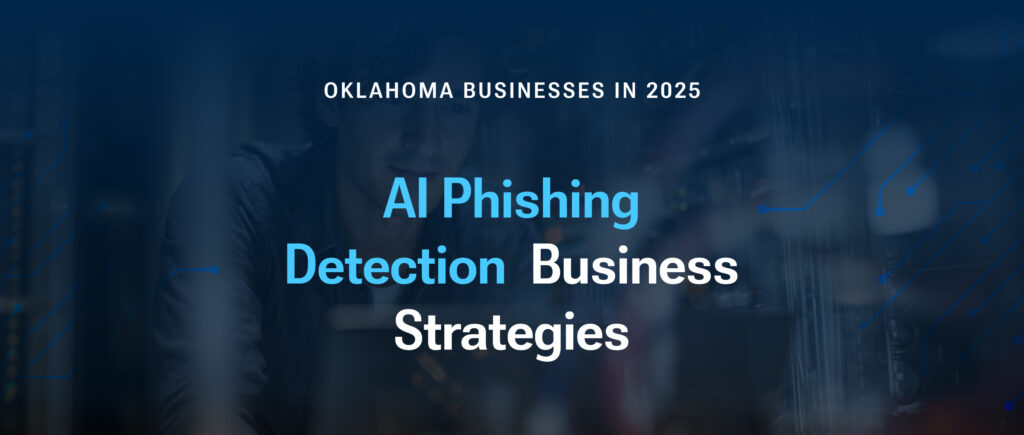For years, we’ve all been trained to spot a phishing email. We look for bad grammar, suspicious links, and a generic salutation. But what happens when the attackers get a lot smarter? Today, thanks to advances in artificial intelligence, cybercriminals are no longer sending poorly-worded messages from overseas. They are leveraging AI to craft perfectly written emails, clone voices, and even create realistic videos to deceive your employees and compromise your business.
For Oklahoma business owners, this is no longer a futuristic movie plot; it’s a real and present danger. A single AI-generated phishing attack or deepfake can bypass your existing defenses and lead to catastrophic data breaches, financial losses, and reputational harm. The good news is that the same technology used to create these threats is also the key to defending against them.
This guide will demystify the new generation of AI-driven email threats SMBs are facing, show you how to defend your team, and explain the critical role of modern AI phishing detection business solutions.
The New Wave of AI-Driven Email Threats SMBs Must Face
The phishing landscape has been transformed by AI. Traditional email filters, which rely on spotting keywords or obvious grammatical errors, are now easily outsmarted. Here’s how AI is making phishing more dangerous than ever:
- Hyper-Personalized Attacks: AI can scour public information, social media, and even past email conversations to create an email that is almost perfectly tailored to your employee. It can mimic the sender’s tone, use specific project names, and refer to real-world events, making the email nearly impossible for a human to flag as fake.
- Zero-Day Attacks: Instead of using a known malicious link, an AI can create a new, unique, and legitimate-looking URL for every single attack. This means it often slips past traditional security tools that rely on a database of known bad sites.
- The Link to Phishing Ransomware: The ultimate goal of many AI-powered phishing campaigns is to install ransomware. A highly believable email is used to deliver a malicious attachment or link. Once an employee clicks, the ransomware is deployed, and your critical business data is held hostage.
Beyond Text: Defending Against Deepfakes and Voice Cloning
As unsettling as AI-powered text is, the real game-changer is the emergence of deepfake technology. These are not just threats for large corporations; they are increasingly targeting small to medium-sized businesses for high-value scams.
What Deepfakes and Voice Cloning Look Like in a Business Context:
- The Urgent Call: An employee in your accounting department receives a call from what sounds exactly like you, the business owner. The voice is calm but insistent, requesting an immediate wire transfer to a new vendor. The employee, hearing a familiar voice and sensing urgency, might bypass standard protocols. This is a classic voice cloning attack prevention scenario.
- The Faked Video Conference: An attacker uses a deepfake video of a trusted partner or executive. During a video call, the fake person asks for access to a sensitive document or instructs an employee to install a piece of software, all while appearing perfectly legitimate on screen.
Without a strategy for deepfake security awareness training, your team may not know how to spot the subtle signs of a deepfake, such as unnatural eye movements, a lack of blinking, or slightly off-sync audio.
Your Best Defense: A Strategic AI Phishing Detection Business Framework
While these threats are formidable, your defense doesn’t have to be a guessing game. The same AI that powers these attacks is also a key component of modern cybersecurity defense. An effective AI phishing detection business strategy leverages this technology to turn the tables on attackers.
Modern AI Cybersecurity tools for businesses operate on a different level than simple spam filters. They can analyze thousands of data points in real time to spot a threat, including:
- Email DNA: The tool can analyze the email’s metadata, header information, and sending server reputation to spot even minor irregularities.
- Behavioral Analysis: It can compare the email to the sender’s typical communication style, flagging anything that seems out of character—a subtle but powerful defense against AI impersonation.
- URL and File Inspection: The system doesn’t just check for known bad links; it can virtually “open” and analyze a file or URL in a secure, isolated environment to see if it exhibits malicious behavior.
This is the core of an effective AI phishing detection business solution—it’s not just looking for a match; it’s looking for anything that doesn’t belong.
Building a Human Firewall: The Role of Cyber Security Training
While technology is your first line of defense, a well-trained team is your most powerful asset. No solution is 100% foolproof, and human vigilance is essential. This is where smart cybersecurity training comes into play.
A robust training program should include:
- AI-Powered Phishing Simulations: Gone are the days of obvious fake emails. Use a phishing simulation artificial intelligence platform that creates realistic, personalized phishing emails to test and train your employees. This provides hands-on experience in a safe environment.
- Deepfake Awareness: Train your team to recognize the red flags of a deepfake or voice cloning attack. Teach them to question urgent, out-of-the-blue requests for financial transfers or sensitive data.
- Establish Verification Protocols: Create a clear, non-negotiable process for verifying sensitive requests. For example, a rule that all financial transfers must be confirmed with a live call to a pre-approved, known phone number—not a number provided in the email or on the deepfake call.
By combining cutting-edge technology with smart, ongoing training, you create a two-pronged defense that is extremely difficult for attackers to penetrate.
Protecting Your Oklahoma Business from Cyber Threats: The Cost of Inaction
For a business owner in Oklahoma, the risk of ignoring these new threats is simply too high. A single data breach can cripple your operations, destroy client trust, and lead to significant financial and legal consequences. Investing in an effective AI phishing detection business strategy and security training isn’t just about protecting your data; it’s about safeguarding the future of your company.
Don’t wait for an AI-powered attack to prove how vulnerable your business is. Get ahead of these threats and put a strategic plan in place today.
Secure your business against tomorrow’s threats, today. Get enterprise-level protection against these new, sophisticated threats. Speak with our experts to learn about a custom AI phishing detection business strategy that fits your unique needs. We can help you build a robust defense.

